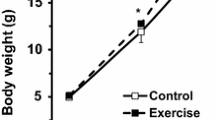Abstract
Cultured fish are bound to experience a variety of potentially stressful situations. In principle, stress may be reduced by adapting fish to intense exercise. This article addresses the effects of chase-induced intense exercise training on rainbow trout. Training reduced fish growth and worsened their nutritional use of food, but had no effect on food intake, biometry or body composition, indicating that a significant fraction of the diet’s energy was being used for exercising rather than growth. Regarding metabolic responses, training significantly counterbalanced lactate, glucose and cortisol plasma concentration increases induced by intense exercise, while completely abolishing that of plasmatic proteins. These data suggest that this type of training adversely affects fish growth and food conversion, whereas it improves their metabolic response capacity and reduces the stress component of forced exercise.
Resumen
En acuicultura, hay múltiples situaciones que pueden generar en los peces una situación de estrés. Un método posible para reducirlo sería habituar a los peces a la ejecución de ejercicio intenso. En este trabajo se estudia el efecto del entrenamiento al ejercicio intenso inducido mediante persecución en la trucha arco iris. Con el entrenamiento se produce una disminución del crecimiento, sin cambios en la ingesta, la biometría ni la composición corporal, pero empeorando la utilización nutritiva de la dieta, lo que indica que parte de la energía de dieta se utiliza en el ejercicio, y no en crecimiento. Con respecto a la respuesta metabólica, el entrenamiento disminuye el incremento en las concentraciones plasmáticas de lactato, glucosa y cortisol que se produce con el ejercicio intenso, y anula este incremento en el caso de las proteínas plasmáticas. Se concluye que este tipo de entrenamiento produce efectos adversos sobre el crecimiento y la conversión del alimento, mejorando, sin embargo, la capacidad metabólica de respuesta de los peces y reduciendo el componente estresante del ejercicio inducido.
Similar content being viewed by others
References
Besner, M. (1980):Diss. Abstr. Int. B,41, 1662.
Butler, P. J. (1986): In “Fish physiology: recent advances” (Nilsson, S. and Holmgren, S. eds.). Croom Helm, London, pp. 102–118.
Christiansen, J. S. and Jobling, M. (1990):Can. J. Zool.,68, 2185–2191.
Davie, P. S., Wells, R. M. G. and Tetens, V. (1986):J. Exp. Zool.,237, 159–171.
Davison, W. (1989):Comp. Biochem. Physiol.,94A, 1–10.
Davison, W. (1997):Comp. Biochem. Physiol.,117A, 67–75.
Farrell, A. P., Johansen, J. A. and Suárez, R. K. (1991):Fish Physiol. Biochem.,9, 303–312.
Forster, I. P. and Ogata, H. (1996):Fisheries Sci.,62, 404–409.
Gamperl, A. K., Bryant, J. and Stevens, E. D. (1988):J. Fish Biol.,33, 861–870.
Gleeson, T. T. (1996):Annu. Rev. Physiol.,58, 565–581.
Holeton, G. F., Neumann, P. and Heisler, N. (1983):Respir. Physiol.,51, 303–318.
Holk, K. and Lykkeboe, G. (1998):J. Exp. Biol.,201, 1373–1380.
Houlihan, D. F. and Laurent, P. (1987):Can. J. Fish. Aquat. Sci.,44, 1614–1621.
Iwama, G. K., Pickering, A. D., Sumpter, J. P. and Schreck, C. B. (1997): Fish stress and health in aquaculture. Cambridge University Press, Cambridge.
Jobling, M., Baardvik, B. M., Christiansen, J. S. and Jorgensen, E. H. (1993):Aquacult. Int.,1, 95–111.
Johnston, I. A. and Moon, T. W. (1980):J. Exp. Biol.,87, 177–194.
Marín Chicano, J. F., Hernández Llorente, M. D., de Costa Ruiz, J., Mendiola López, P. and Zamora Navarro, S. (1999):J. Physiol. Biochem.,55, 293–300.
Martínez López, F. J., García-Riera, M. P., Canteras, M., de Costa Ruiz, J. and Zamora Navarro, S. (1992):Arch. Int. Physiol. Biochim. Biophys.,100, 345–348.
Milligan, C. L. (1996):Comp. Biochem. Physiol.,113A, 51–60.
Milligan, C. L. and Girard, S. S. (1993):J. exp. Biol.,180, 175–193.
Nahhas, R., Jones, N. V. and Goldspink, G. (1982):J. mar. biol. Ass. U. K.,62, 699–708.
Pearson, M. P., Spriet, L. L. and Stevens, E. D. (1990):J. Exp. Biol.,149, 45–60.
Ried, S. G., Furimsky, M. and Perry, S. F. (1994):J. Fish Biol.,45, 365–378.
Rotllant, J., Balm, P. H. M., Pérez-Sánchez, J., Wendelaar-Bonga, S. E. and Tort Bardolet, L. (2001):Gen. Comp. Endocrinol.,121, 333–342.
van Weerd, J. H. and Komen, J. (1998):Comp. Biochem. Physiol.,120A, 107–112.
Wendelaar Bonga, S. E. (1997):Physiol. Rev.,77, 591–525.
Wood, C. M. and Perry, S. F. (1985): in “Circulation, Respiration, and Metabolism. Current comparative approaches” (Gilles, R. ed.), Springer-Verlag, Berlin. pp. 2–22.
Woodward, J. J. and Smith, L. S. (1985):J. Fish Biol.,26, 435–447.
Yamamoto, K. I. and Itazawa, Y. (1989):Comp. Biochem. Physiol.,92A, 139–144.
Young, P. S. and Cech, J. J., Jr. (1993):Can. J. Fish. Aquat. Sci.,50, 703–707.
Young, P. S. and Cech, J. J., Jr. (1993):Can. J. Fish. Aquat. Sci.,50, 2094–2099.
Young, P. S. and Cech, J. J., Jr. (1994):Can. J. Fish. Aquat. Sci.,51, 1519–1527.
Young, P. S. and Cech, J. J., Jr. (1994):Can. J. Fish. Aquat. Sci.,51, 1528–1534.
Author information
Authors and Affiliations
Corresponding author
Rights and permissions
About this article
Cite this article
Hernández, M.D., Mendiola, P., de Costa, J. et al. Effects of intense exercise training on rainbow trout growth, body composition and metabolic responses. J. Physiol. Biochem. 58, 1–7 (2002). https://doi.org/10.1007/BF03179832
Received:
Issue Date:
DOI: https://doi.org/10.1007/BF03179832



